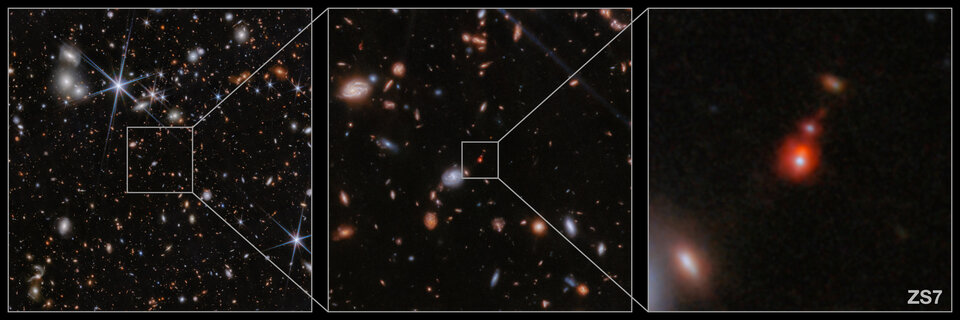Astronomers have discovered the most distant pair of interacting supermassive black holes. The duo was in the process of merging when the universe was just 740 million years old. The light of the system, dubbed ZS7, traveled over 13 billion years to reach us and the observations are providing insights into how supermassive black holes grow to the enormous size that we see today.
Not that these two black holes are small. They are already 10 times heavier than Sagittarius A*, the supermassive black hole at the center of the Milky Way. The astronomers were able to estimate the mass of one of them directly, placing it at 50 million times the mass of our Sun.
This image shows the location of the galaxy system ZS7.
“The mass of the other black hole is likely similar, although it is much harder to measure because this second black hole is buried in dense gas,” co-author Professor Roberto Maiolino, from the Kavli Institute for Cosmology, said in a statement.
The key to this discovery was the incredible power of JWST. The infrared space telescope was able to track the distinct signatures of a supermassive black hole accreting matter. Such signatures are inaccessible to ground-based telescopes.
“We found evidence for very dense gas with fast motions in the vicinity of the black hole, as well as hot and highly ionised gas illuminated by the energetic radiation typically produced by black holes in their accretion episodes,” said lead author Dr Hannah Übler of Cambridge’s Cavendish Laboratory and the Kavli Institute for Cosmology.
These are telltale signs of the activity of the two black holes. JWST was able to see details of ZS7 showing that it is an interacting system and that it will eventually merge into a much bigger single object.
Such observations help astronomers better understand the process that leads certain supermassive black holes to be absolutely enormous, billions of times the mass of our Sun. JWST has provided several examples of supermassive black holes very early in the universe that are already quite sizable. The new observations provide insights into a different pathway for their remarkable size and growth.
“Our findings suggest that merging is an important route through which black holes can rapidly grow, even at cosmic dawn,” said Übler.
The future gravitational observatory LISA will be able to measure the gravitational waves of supermassive black holes such as these merging. It is scheduled to be launched in the 2030s.
A paper describing these results is published in the journal Monthly Notices of the Royal Astronomical Society.
Source Link: Webb Telescope Spots Most Distant Black Hole Merger Ever Detected
